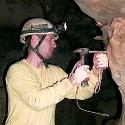Lithium Ion Powered Drill
Moderator: Moderators
13 posts
• Page 1 of 1
Lithium Ion Powered Drill
Over the past few months I have designed and built a high performance lithium ion battery pack for my rotary hammer drill that I use for dome climbing. Did some performance testing and it drills into limestone like crazy. When fully charged the battery is at 42 volts and it just tears into rock like mad. It could drill a 3/8ths 3 inch deep hole in 15 seconds flat!
The battery pack is fairly small and weighs only 3 pounds. It is 36 volts and 6.6 amp hours, with enough power to set 75-100 bolts on one charge (3/8ths 1-3/4").
The video is when the pack was half discharged and I had already
drilled about 40 holes (3/8ths 1-3/4"). I finally got tired of drilling holes and gave up. This lithium battery is unreal...
http://www.youtube.com/watch?v=KpPsH9-oVcQ
Applications include being able to instantly set bolts for rigging during cave rescues and drilling holes for rock shaving during patient extraction or just plain exploration. For rock shaving I calculated this battery has enough power to drill 14 feet of 5/16ths hole. That is about 28 shots worth.
The battery pack is fairly small and weighs only 3 pounds. It is 36 volts and 6.6 amp hours, with enough power to set 75-100 bolts on one charge (3/8ths 1-3/4").
The video is when the pack was half discharged and I had already
drilled about 40 holes (3/8ths 1-3/4"). I finally got tired of drilling holes and gave up. This lithium battery is unreal...
http://www.youtube.com/watch?v=KpPsH9-oVcQ
Applications include being able to instantly set bolts for rigging during cave rescues and drilling holes for rock shaving during patient extraction or just plain exploration. For rock shaving I calculated this battery has enough power to drill 14 feet of 5/16ths hole. That is about 28 shots worth.
-

tagcaving - Occasional Poster
- Posts: 39
- Joined: Feb 8, 2007 1:46 pm
- Location: Georgia
I calculated this battery has enough power to drill 14 feet of 5/16ths hole.
I dont know Andy...I'll do and push about anything to get some more virgin cave..and I can fit in some tight stuff....but a 5/16ths diameter hole might be a bit rougher than than Agony Avenue in the back of Warrens..
Get it up to 3/4" diameter and it will start to be respectable...
I guess you could do a forward shot using a laser disto and still add it to the survey though...and 2 to 3 body length "lead" heading off into a blank part of the map is always intriguing...
Now if ONLY you could get 2 lithium ions to work together....then you'd REALLY have "more power"...but then you'd probably have to be of scottish ancestry to get it to work right...not that there is anything wrong with that! And you'd probably have to go pretty far to refuel it....
Its a joke...for nerds..get it? And if you do dont spill the beans...let everyone suffer trying to figure it out :)
Still, sounds pretty impressive...I just ran across a video of a paraglider powered by a pack of lithium ions....I'd never thought you could get something to fly worth a hoot with batteries...particularly something as inefficient as a powered paraglider...I'll have to dig up the link and post it here sometime.
Blll
I dont know Andy...I'll do and push about anything to get some more virgin cave..and I can fit in some tight stuff....but a 5/16ths diameter hole might be a bit rougher than than Agony Avenue in the back of Warrens..
Get it up to 3/4" diameter and it will start to be respectable...
I guess you could do a forward shot using a laser disto and still add it to the survey though...and 2 to 3 body length "lead" heading off into a blank part of the map is always intriguing...
Now if ONLY you could get 2 lithium ions to work together....then you'd REALLY have "more power"...but then you'd probably have to be of scottish ancestry to get it to work right...not that there is anything wrong with that! And you'd probably have to go pretty far to refuel it....
Its a joke...for nerds..get it? And if you do dont spill the beans...let everyone suffer trying to figure it out :)
Still, sounds pretty impressive...I just ran across a video of a paraglider powered by a pack of lithium ions....I'd never thought you could get something to fly worth a hoot with batteries...particularly something as inefficient as a powered paraglider...I'll have to dig up the link and post it here sometime.
Blll
- bill fish
- Frequent Poster
- Posts: 96
- Joined: Feb 23, 2006 9:12 am
Very good, my friend! 
So when are you going to make up a set for the SE-NCRC?

So when are you going to make up a set for the SE-NCRC?

Be safe,
Tim White 26949 RL FE
Southeastern Region Coordinator - NCRC
Editor, Nylon Highway
Senior Technical Manager - Over the Edge, Inc.
Tim White 26949 RL FE
Southeastern Region Coordinator - NCRC
Editor, Nylon Highway
Senior Technical Manager - Over the Edge, Inc.
-

Tim White - Global Moderator
- Posts: 848
- Joined: Sep 8, 2005 11:57 am
- Location: Suwanee, GA
Well bill, that is what my other invention is for, the Matter of Fact Compactor 
You step inside and it changes your shape so you can fit. The only problem is that it will only shrink you down to small enough to go through as a belly crawl. 14 feet at 5/16ths is like 1400 feet when you are that small like an ant. There is also a certain amount of time before you spontaneously expand. If this occurs inside the tunnel...well...lets say it is not a pretty sight! However, this causes instant rock expansion and after your buddy clears out all debris, they can just crawl through like normal and scoop all the virgin passage.

You step inside and it changes your shape so you can fit. The only problem is that it will only shrink you down to small enough to go through as a belly crawl. 14 feet at 5/16ths is like 1400 feet when you are that small like an ant. There is also a certain amount of time before you spontaneously expand. If this occurs inside the tunnel...well...lets say it is not a pretty sight! However, this causes instant rock expansion and after your buddy clears out all debris, they can just crawl through like normal and scoop all the virgin passage.
-

tagcaving - Occasional Poster
- Posts: 39
- Joined: Feb 8, 2007 1:46 pm
- Location: Georgia
Hmm, any issues with overheating? I don't suppose you could post a schematic and some info on how you got your materials. I've been able to get a good number of holes with my 24v bosch but not needing to recharge a battery every day would be nice.
James
James
- hunter
- NSS Hall Of Fame Poster
- Posts: 395
- Joined: Sep 9, 2005 9:47 am
- Location: New Mexico
I did not find much overheating after drilling for 10 minutes straight. The drill got rather hot around the motor and the wires felt a little warm. Three cells are in parallel and are discharged up to a max 2C rate, limited by the polyfuse. In practice, the drill is only runs for 30 second bursts at a time to drill a hole. What is important is to allow lithium ion cells a chance to rest after a high discharge pulse and cool down. While dome climbing this is not a problem. The drill is 350 watts so it pulls about 10 amps under a load. Upon start up it pulls 15 amps for a fraction of a second, which is not enough time to blow the 14 amp polyfuse.
-

tagcaving - Occasional Poster
- Posts: 39
- Joined: Feb 8, 2007 1:46 pm
- Location: Georgia
Follow Up Report
Took the battery out last weekend for its first real test. Friday night I dropped a 200+ foot wet pit and helped some friends do some rock shaving, drilling 14 holes. Without recharging the battery pack, I then used it the next day and climbed an 85 foot dome, setting 16 3/8ths bolts, over-drilling the holes. After pulling down out of the dome the drill was used to do more rock shaving nearby to get into a virgin pit. Five 10 inch deep 3/8ths holes were drilled. When I got out of the cave the battery had a resting voltage of 38.1 volts indicating it was still not discharged.
Totals:
117 inches of 3/8" hole
54 inches of 5/16" hole
This equals to 17 cubic inches of rock removed.
Even while drilling 10 inch deep holes continuously, the battery never felt warm. The drill motor got very warm though. This is a good sign and shows the battery is performing better than expected. It is nice to know I can go all weekend and have enough power to do multiple projects with just one battery.
I have revised my estimate and believe the battery has enough power to drill 150 bolts (1-3/4" x 3/8") or 25 feet of 3/8" hole per charge. At 3 pounds and the size of two fists the battery easily fit inside a small foam padded Pelican box.
Totals:
117 inches of 3/8" hole
54 inches of 5/16" hole
This equals to 17 cubic inches of rock removed.
Even while drilling 10 inch deep holes continuously, the battery never felt warm. The drill motor got very warm though. This is a good sign and shows the battery is performing better than expected. It is nice to know I can go all weekend and have enough power to do multiple projects with just one battery.
I have revised my estimate and believe the battery has enough power to drill 150 bolts (1-3/4" x 3/8") or 25 feet of 3/8" hole per charge. At 3 pounds and the size of two fists the battery easily fit inside a small foam padded Pelican box.
-

tagcaving - Occasional Poster
- Posts: 39
- Joined: Feb 8, 2007 1:46 pm
- Location: Georgia
Excellent!!! Great progress and amazing results.
Did you post an article about the specifics in Cave diggers?
I might have to pursue this set up.
Thanks for sharing the progress.
Did you post an article about the specifics in Cave diggers?
I might have to pursue this set up.
Thanks for sharing the progress.
- barcelonacvr
- NSS Hall Of Fame Poster
- Posts: 312
- Joined: Oct 26, 2005 5:23 pm
What drill are you using this with? Is it a 24V, 36V, or other drill?
Can you post a few more details about how the battery is built, eg. what sort of cells, how are they wired, did you need to add an overdraw protection circuit, how you charge it...?
Inquiring minds want to know!
Can you post a few more details about how the battery is built, eg. what sort of cells, how are they wired, did you need to add an overdraw protection circuit, how you charge it...?
Inquiring minds want to know!
-

driggs - NSS Hall Of Fame Poster
- Posts: 495
- Joined: Sep 12, 2005 9:40 pm
- Location: State of Jefferson
- Name: David A. Riggs
- NSS #: 56189
- Primary Grotto Affiliation: Monongahela
Sure, no problem. 36 volt Hilti rotary hammer drill, 350 watts. 10s3p pack of 2200mah 18650s, pushed to a maximum discharge rate of 2C per cell, limited by a 14 amp polyfuse. No PCB, but pack made of five 2s3p packs charged separate and monitored manually. All packs plug into a series wiring harness to power drill.
Note: 2C is beyond the designed the 1C current load for such cells and pushes them to their limits. This may cause them to explode and vent with flame. Without a PCB build and use at your own risk, including possible injury and lost of property due to spontaneous lithium battery fires. I charge and store my batteries in an empty fireplace at home and transport in a fire resistant locked safe.
Note: 2C is beyond the designed the 1C current load for such cells and pushes them to their limits. This may cause them to explode and vent with flame. Without a PCB build and use at your own risk, including possible injury and lost of property due to spontaneous lithium battery fires. I charge and store my batteries in an empty fireplace at home and transport in a fire resistant locked safe.
-

tagcaving - Occasional Poster
- Posts: 39
- Joined: Feb 8, 2007 1:46 pm
- Location: Georgia
tagcaving wrote: I ... transport in a fire resistant locked safe.
Wow, Andy! you are WAY more caver tough than me. I could never lug a safe through a cave.


Be safe,
Tim White 26949 RL FE
Southeastern Region Coordinator - NCRC
Editor, Nylon Highway
Senior Technical Manager - Over the Edge, Inc.
Tim White 26949 RL FE
Southeastern Region Coordinator - NCRC
Editor, Nylon Highway
Senior Technical Manager - Over the Edge, Inc.
-

Tim White - Global Moderator
- Posts: 848
- Joined: Sep 8, 2005 11:57 am
- Location: Suwanee, GA
 Thanks Tim! Sorry to be so serious about all this, but lithium batteries are starting to be used by cavers now. (If you use a Sten light you most likely have lithium ion batteries.) Just wanted to make sure the people who begin to use these batteries fully understand the dangers they pose. You can not treat these batteries like other batteries you use. Lithium ion batteries do not tolerate the abuse that people are able to throw at other batteries and get away with. Instead, they bite back.
Thanks Tim! Sorry to be so serious about all this, but lithium batteries are starting to be used by cavers now. (If you use a Sten light you most likely have lithium ion batteries.) Just wanted to make sure the people who begin to use these batteries fully understand the dangers they pose. You can not treat these batteries like other batteries you use. Lithium ion batteries do not tolerate the abuse that people are able to throw at other batteries and get away with. Instead, they bite back.
Before I built this lithium ion battery pack I did an extensive amount of research. As long as you treat these batteries with respect, handle them like you are supposed too, they are fine. People who build their own lithium battery packs often push their lithium batteries beyond their limits. This can create damage inside the battery you can not see. Minutes to hours later a battery can decide to spontaneously short circuit itself and go into a runaway reaction. The natural result you see is the battery spontaneously exploding or catching on fire. Even if you do everything you are supposed to do, they can still spontaneously catch fire due to a manufacturing defect. Think the Sony Battery Laptop recall.
The fire resistant document safe has a hydrated mineral in the walls. When heated to high temperature it release the water and keeps the documents inside from burning. If lithium batteries are put inside such a safe and catch fire, it does the same thing, contains the fire inside, absorbs the energy, and prevents the fire from escaping. This safe is not that big or that heavy. I only use it to store my batteries in my truck while out caving. While in the cave I transport my lithium battery in a waterproof pelican box.
If you are interested in another layer of protection, we can take a tip from the RC community. They store their Li-Poly cells in a Sentry fire document box. I believe they are around $25 at Target and Wal Mart. Holes are drilled into the box to allow rapid gas venting. The box is kept in a safe place with the vent holes pointed away from combustible surfaces.
The Brinks cash box has also been used. Once again vent holes are needed because the rapid gas build up will pop the latch and the lid will fly open. The Brinks box is not insulated, so it must be kept off of combustible surfaces as well as the vent holes pointed away from such surfaces. Partitions can be utilized inside the box to try to isolate sections, but the boxes are not that expensive so people are purchasing several, spreading out their cells amongst several boxes.
http://candlepowerforums.com/vb/showpost.php?p=883411&postcount=56
-

tagcaving - Occasional Poster
- Posts: 39
- Joined: Feb 8, 2007 1:46 pm
- Location: Georgia
13 posts
• Page 1 of 1
Who is online
Users browsing this forum: Google [Bot]


